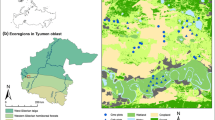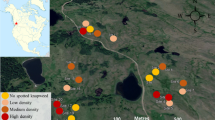Abstract
Fire is a frequent disturbance in grassland ecosystems enabling variability in habitat characteristics and creating important environmental filters for community assembly. Changes in vegetation have a large influence on herbivore insect assemblages. Here, we explored the responses of grasshoppers to disturbance by fire in grasslands of southern Brazil through a small-scale experiment based in paired control and burned plots. The resilience of grasshoppers was assessed by monitoring changes to their abundance, taxonomic, and functional parameters along time. Burned patches have been already recolonized by grasshoppers 1 month after fire and did not differ in terms of abundance and richness from control areas in any evaluated time within 1 year. Simpson diversity decreased 1 month after fire due to the increased dominance of Dichroplus misionensis (Carbonell) and Orphulella punctata (De Geer). In this period, grasshoppers presented in average a smaller body and a larger relative head size; these are typically nymph characteristics, which are possibly indicating a preference of juveniles for the young high-quality vegetation, or a diminished vulnerability to predation in open areas. Further, at 6 months after fire grasshoppers with smaller relative hind femur and thus lower dispersal ability seemed to be benefitted in burned patches. Finally, 1 year after fire grasshoppers became more similar to each other in relation to their set of traits. This study demonstrates how taxonomic and functional aspects of grasshopper assemblages can be complementary tools to understand their responses to environmental change.



Similar content being viewed by others
References
Bergamaschi H, Guadagnin MR (1990) Agroclima da Estação Experimental Agronômica. Universidade Federal do Rio Grande do Sul, Porto Alegre, p 96
Bernays EA, Hamai J (1987) Head size and shape in relation to grass feeding in Acridoidea (Orthoptera). Int J Insect Morphol Embryol 16:323–330
Bernays EA, Jarzembowski EA, Malcolm SB (1991) Evolution of insect morphology in relation to plants [and Discussion]. Philos Trans R Soc Lond B 333:257–264
Bond WJ, Woodward FI, Midgley GF (2005) The global distribution of ecosystems in a world without fire. New Phytol 165:525–538
Botta-Dukát Z (2005) Rao’s quadratic entropy as a measure of functional diversity based on multiple traits. J Veg Sci 16:533–540
Branson DH (2005) Effects of fire on grasshopper assemblages in a northern mixed-grass prairie. Environ Entomol 34:1109–1113
Campos JV, Garcia FRM, da Costa MKM (2001) Ocorrência de duas espécies de gafanhotos (Orthoptera, Caelifera) alimentando-se de plantas cítricas no Extremo Oeste de Santa Catarina Brasil. Biotemas 14:157–160
Capinera JL, Scott RD, Walker TJ (2004) Field guide to grasshoppers, katydids and crickets of the United States and Canada. Cornell University Press, Ithaca, p 249
Castro I, Bravo F (2001) Morfologia externa do gafanhoto adulto Eutropidacris sp.: Comentários sobre o plano básico de Hexapoda. Editora Imprensa Universitária UEFS, p 61
Chambers BQ, Samways MJ (1998) Grasshopper response to a 40-year experimental burning and mowing regime, with recommendations for invertebrate conservation management. Biodivers Conserv 7:985–1012
Chapman RF (2009) Mouthparts. In: Resh VH, Cardé RT (eds) Encyclopedia of insects. Academic, San Diego, pp 729–732
Der Plas FV, Anderson TM, Olff H (2012) Trait similarity patterns within grass and grasshopper communities: multitrophic community assembly at work. Ecology 93:836–846
Engstrom RT (2010) First-order fire effects on animals: review and recommendations. Fire Ecol 6:115–130
Fidelis A, Müller SC, Pillar DV, Pfadenhauer J (2010) Population biology and regeneration of forbs and shrubs after fire in Brazilian Campos grasslands. Plant Ecol 211:107–117
Ford PL (2007) Shared community patterns following experimental fire in a semiarid grassland. In: Proceedings of the 4th International Wildland Fire Conference, Seville, Spain
Fuhlendorf SD, Engle DM (2001) Restoring heterogeneity on rangelands: ecosystem management based on evolutionary grazing patterns. BioScience 51:625–632
Fuhlendorf SD, Engle DM, Kerby J, Hamilton R (2008) Pyric herbivory: rewilding landscapes through the recoupling of fire and grazing. Conserv Biol 23:588–598
Garnier E, Cortez J, Billes G, Navas ML, Roumet C, Debussche M, Laurent G, Blanchard A, Aubry D, Bellmann A, Neill C, Toussaint JP (2004) Plant functional markers capture ecosystem properties during secondary succession. Ecology 85:2630–2637
Gardiner T, Gardiner M, Hill J (2005) The effect of pasture improvement and burning on Orthoptera populations of Culm grasslands in northwest Devon, UK. J Orthopt Res 14:153–159
Grime JP (1977) Evidence for the existence of three primary strategies in plants and its relevance to ecological and evolutionary theory. Am Nat 111:1169–1194
Ibanez S, Manneville O, Miquel C, Taberlet P, Valentini A, Aubert S, Coissac E, Colace M, Duparc Q, Lavorel S, Moretti M (2013a) Plant functional traits reveal the relative contribution of habitat and food preferences to the diet of grasshoppers. Oecologia 173:1459–1470
Ibanez S, Lavorel S, Puijalon S, Moretti M (2013b) Herbivory mediated by coupling between biomechanical traits of plants and grasshoppers. Funct Ecol 27:479–489
Isely FB (1944) Correlation between mandibular morphology and food specificity in grasshoppers. Ann Entomol Soc Am 37:47–67
Joern A, Laws AN (2013) Ecological mechanisms underlying arthropod species diversity in grasslands. Annu Rev Entomol 58:19–36
Kottek M, Grieser J, Beck C, Rudolf B, Rubel F (2006) World map of the Köppen-Geiger climate classification updated. Meteorol Z 15:259–263
Loreau M, Naeem S, Inchausti P, Bengtsson J, Grime JP, Hector A, Hooper DU, Huston MA, Raffaelli D, Schmid B, Tilman D, Wardle DA (2001) Biodiversity and ecosystem functioning: current knowledge and future challenges. Science 294:804–808
Lutinski CJ, Garcia FRM, da Costa MKM, Lutinski JA (2009) Flutuação populacional de gafanhotos na Floresta Nacional de Chapecó, Santa Catarina. Ciênc Rural 39:555–558
Mariottini Y, Wysiecki MLD, Lange CE (2011) Seasonal occurrence of life stages of grasshoppers (Orthoptera:Acridoidea) in the Southern Pampas, Argentina. Zool Stud 50:737–744
McGill BJ, Enquist BJ, Weiher E, Westoby M (2006) Rebuilding community ecology from functional traits. Trends Ecol Evol 21:178–185
McGranahan DA, Raicovich GM, Wilson WN (2013) Preliminary evidence that patch burn-grazing creates spatially heterogeneous habitat structure in old-field grassland. Southeast Nat 12:655–660
Morris MG (2000) The effects of structure and its dynamics on the ecology and conservation of arthropods in British grasslands. Biol Conserv 95:129–142
Nadeau L, Cushing PE, Kondratieff BC (2006) Effects of fire disturbance on grasshopper (Orthoptera: Acrididae) assemblages of the Comanche National Grasslands, Colorado. J Kansas Entomol Soc 79:2–12
Overbeck GE, Müller SC, Pillar VD, Pfadenhauer J (2005) Fine-scale post-fire dynamics in southern Brazilian subtropical grassland. J Veg Sci 16:655–664
Overbeck GE, Pfadenhauer J (2007) Adaptive strategies in burned subtropical grassland in southern Brazil. Flora 202:27–49
Overbeck GE, Müller SC, Fidelis A, Pfadenhauer J, Pillar VD, Blanco CC, Boldrini II, Both R, Forneck ED (2007) Brazil’s neglected biome: the south Brazilian Campos. Perspect Plant Ecol Evol Syst 9:101–116
Parmenter RR, Kreutzian M, Moore DI, Lightfoot DC (2011) Short-term effects of a summer wildfire on a desert grassland arthropod community in New Mexico. Entomol Soc Am 40:1051–1066
Patterson BD (1984) Correlation between mandibular morphology and specific diet of some desert grassland Acrididae (Orthoptera). Am Midl Nat 11:296–303
Picaud F, Petit DP (2007) Primary succession of Acrididae (Orthoptera): differences in displacement capacities in early and late colonizers of new habitats. Acta Oecol 32:59–66
Pillar VD (1997) Multivariate exploratory analysis and randomization testing with MULTIV. Coenoses 12:145–148
Pillar VD, Vélez E (2010) Extinção dos campos sulinos em unidades de conservação: um fenômeno natural ou um problema ético? Nat Conserv 8:84–86
Pocco ME, Damborsky MP, Cigliano MM (2010) Comunidades de ortópteros (Insecta, Orthoptera) en pastizales del Chaco Oriental Húmedo, Argentina. Anim Biodivers Conserv 33:119–129
Podgaiski LP, Joner F, Lavorel S, Moretti M, Ibanez S, Mendonça MDS Jr, Pillar VD (2013) Spider trait assembly patterns and resilience under fire-Induced vegetation change in south Brazilian grasslands. PLoS One 8(3):e60207. doi:10.1371/journal.pone.0060207
Podgaiski LR, Goldas CS, Ferrando CPR, Silveira FS, Joner F, Overbeck GE, Mendonça MDS Jr, Pillar VD (2014) Burning effects on detritivory and litter decay in Campos grasslands. Austral Ecol 39:686–695
Rácz IA, Déri E, Kisfali M, Batiz Z, Varga K, Szabó G, Lengyel S (2013) Early changes of orthopteran assemblages after grassland restoration: a comparison of space-for-time substitution versus repeated measures monitoring. Biodivers Conserv 22:2321–2335
Ricotta C, Moretti M (2011) CWM and Rao’s quadratic diversity: a unified framework for functional ecology. Oecologia 167:181–188
Ronderos RA, Carbonell CS, Mesa A (1968) Revisión de las especies del género Dichroplus Stal, del grupo elongatus (Orthoptera, Acrididae, Catantopinae). Revista del Museo La Plata 10:271–325
Swengel AB (2001) A literature review of insect responses to fire, compared to other conservation managements of open habitat. Biodivers Conserv 10:1141–1169
Tilman D (2001) Functional diversity. In: Levin SA (ed) Encyclopedia of biodiversity. Academic, San Diego, pp 109–120
Vandewalle M, de Bello F, Berg MP, Bolger T, Dolédec S, Dubs F, Feld CK, Harrington R, Harrison PA, Lavorel S, da Silva PM, Moretti M, Niemela J, Santos P, Sattler T, Sousa JP, Sykes MT, Vanbergen AJ, Woodcock BA (2010) Functional traits as indicators of biodiversity response to land use changes across ecosystems and organisms. Biodivers Conserv 19:2921–2947
Vasconcelos HL, Pacheco R, Silva RC, Vasconcelos PB, Lopes CT, Costa AN, Bruna EM (2009) Dynamics of the leaf-litter arthropod fauna following fire in a neotropical woodland savanna. PLoS One 4:e7762
Violle C, Navas ML, Vile D, Kazakou E, Fortunel C, Hummel I, Garnier E (2007) Let the concept of trait be functional! Oikos 116:882–892
White PS, Jentsch A (2001) The search for generality in studies of disturbance and ecosystem dynamics. Prog Bot 62:399–450
Whitman DW (2008) The significance of body size in the Orthoptera: a review. J Orthopt Res 17:117–134
Acknowledgments
We appreciated the help received from Camila da Silva Goldas and Fernando Joner in the fieldwork and the support from the team in Laboratório de Ecologia de Interações, especially Fernando Albuquerque Luz for the support in figure editing (UFRGS). We are also grateful to the Conselho Nacional de Desenvolvimento Científico (CNPq) for the financial support (Research Productivity Scholarship to MSMJ, process 309348/2012-9) and to Valério D. Pillar for the coordination of the wider project.
Author information
Authors and Affiliations
Corresponding author
Additional information
Edited by Kleber del Claro – UFU
Electronic supplementary material
Below is the link to the electronic supplementary material.
Online Supplementary Material 1
(DOCX 86 kb)
Online Supplementary Material 2
(DOCX 603 kb)
Rights and permissions
About this article
Cite this article
Ferrando, C.P.R., Podgaiski, L.R., Costa, M.K.M. et al. Taxonomic and Functional Resilience of Grasshoppers (Orthoptera, Caelifera) to Fire in South Brazilian Grasslands. Neotrop Entomol 45, 374–381 (2016). https://doi.org/10.1007/s13744-016-0380-3
Received:
Accepted:
Published:
Issue Date:
DOI: https://doi.org/10.1007/s13744-016-0380-3




